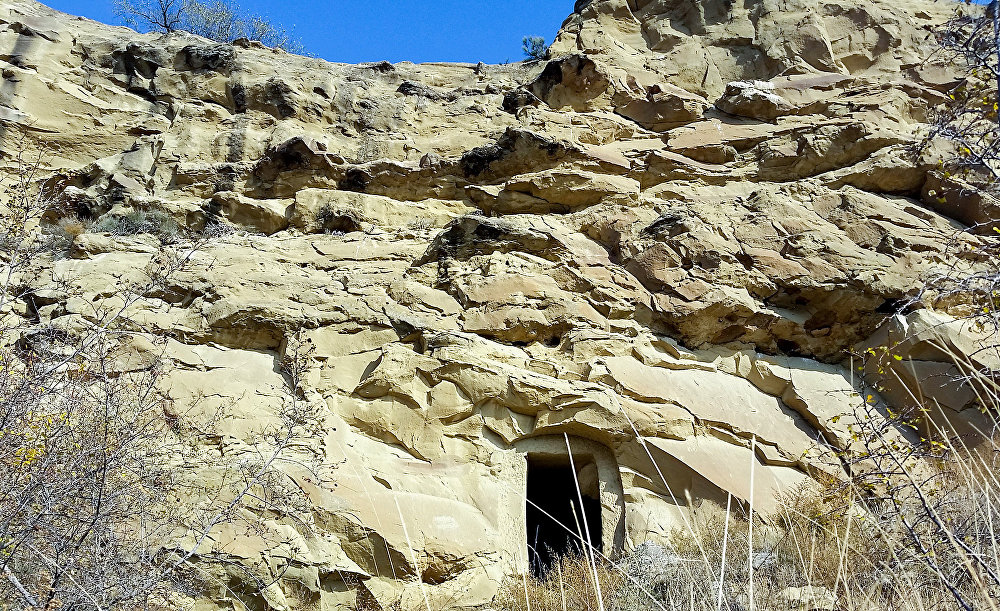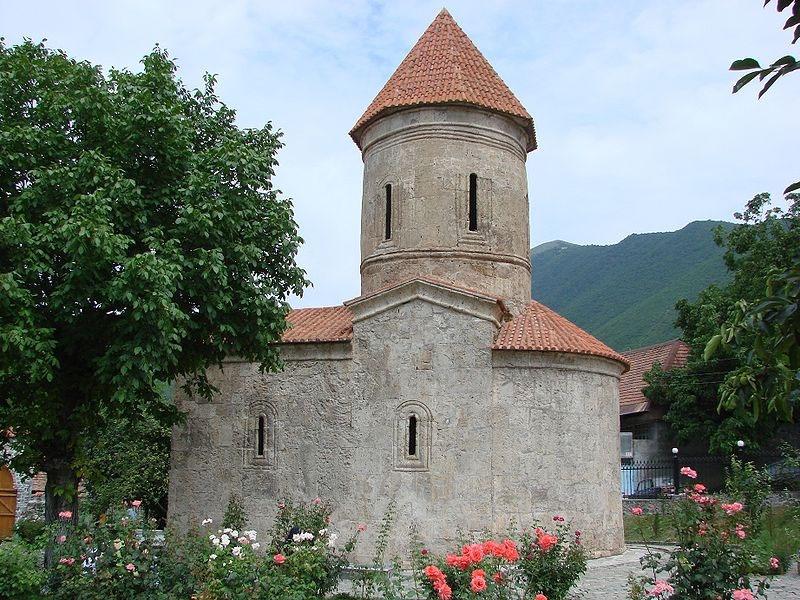Due to its mild climate and favourable conditions for humans, Azerbaijan was one of the first places where ancient human civilizations occurred. The results of archaeological excavations demonstrated that ancient people in Azerbaijan created numerous works of arts, specifically architectural monuments.
 The architecture reflects the history of the humankind. It started with natural caves that served as homes for ancient people. Azerbaijan has numerous such caves within its territory, particularly in the foothills of the Major Caucasus and Minor Caucasus Mountains, in the Talysh Mountains, in the Nakhichevan Autonomous Republic, in Zangilan, Kalbadjar, Gadabay, Khanlar, Shamaxi as well as the Azikh cave, which was discovered in the territory of the Fuzuli region. It was determined that people lived in those caves nearly 1.5 million years ago and tried to adapt natural caves to their lifestyle as a result of increasing awareness and the development of labour and building tools. They drilled hole (flues) in the ceiling to guide fire smoke out of the cave, and they made special hollows into internal walls to keep their tools. The construction works that were carried out in caves by the ancient people resulted in the appearance of artificial caves in later stages. The artificial caves were made into sheer cliffs and at the foothills of the mountains, just as natural caves are situated. They can be found in the south-eastern foothills of the Major Caucasus, in the Minor Caucasus, on the Bargushad and Akara banks in the Gubadli region, near the villages of Maraza, Sundi and Darakandi in the Shirvan region, as well as in the territories, which long ago belonged to the ancient states of Manna and Midia. Wherever the artificial caves were built, ancient people tried to build them at a certain height above ground level for security purposes. The methods of artificial cave construction started changing after the invention of masonry. People began to build new mud and half-mud huts after masonry was invented. Such buildings were usually constructed into mountainsides and hillsides. Ancient people did not have strong skills in masonry building and were not capable of constructing buildings to their desired height. They created an underground grotto in the lower part, while the upper part (the entrance) served as a porch of natural stones to protect them from heat and cold. Scientists report that such buildings existed even before the state of Midiya and were widespread during the period of Midia.
The architecture reflects the history of the humankind. It started with natural caves that served as homes for ancient people. Azerbaijan has numerous such caves within its territory, particularly in the foothills of the Major Caucasus and Minor Caucasus Mountains, in the Talysh Mountains, in the Nakhichevan Autonomous Republic, in Zangilan, Kalbadjar, Gadabay, Khanlar, Shamaxi as well as the Azikh cave, which was discovered in the territory of the Fuzuli region. It was determined that people lived in those caves nearly 1.5 million years ago and tried to adapt natural caves to their lifestyle as a result of increasing awareness and the development of labour and building tools. They drilled hole (flues) in the ceiling to guide fire smoke out of the cave, and they made special hollows into internal walls to keep their tools. The construction works that were carried out in caves by the ancient people resulted in the appearance of artificial caves in later stages. The artificial caves were made into sheer cliffs and at the foothills of the mountains, just as natural caves are situated. They can be found in the south-eastern foothills of the Major Caucasus, in the Minor Caucasus, on the Bargushad and Akara banks in the Gubadli region, near the villages of Maraza, Sundi and Darakandi in the Shirvan region, as well as in the territories, which long ago belonged to the ancient states of Manna and Midia. Wherever the artificial caves were built, ancient people tried to build them at a certain height above ground level for security purposes. The methods of artificial cave construction started changing after the invention of masonry. People began to build new mud and half-mud huts after masonry was invented. Such buildings were usually constructed into mountainsides and hillsides. Ancient people did not have strong skills in masonry building and were not capable of constructing buildings to their desired height. They created an underground grotto in the lower part, while the upper part (the entrance) served as a porch of natural stones to protect them from heat and cold. Scientists report that such buildings existed even before the state of Midiya and were widespread during the period of Midia.
At first, masonry was used in front sides and laterals, then in backsides of the grotto in the next development period of buildings of cave type. Replacing of flat walls by masonry and improvement of people's construction skill led gradually to appearance of overground buildings.
The buildings based on artificial caves passed a long way of historical development and became known under the name of Garadan in the history of architecture. Garadans that were built in Azerbaijan were gradually adapted to the local climatic condition and acquired various architectural-planning qualities. Domestic animals were usually kept in such residents as well. According to the historical sources, garadans were used in Azerbaijan until the beginning of the 20th century.
Megalith architectural monuments-cromlechs, menhirs (herdsman's stone), dolmens and Cyclopes buildings were widespread along with the oldest places of residence found in Gobustan (caves, different primitive shelters and etc.).
These monuments made of high stones are called "galadja" or "horukdash" by people. Defence buildings as Chalkhangala near Nakhichevan (Bronze epoch) and Oglangala on the bank of the Arpachay river (II-I thousand years B.C) belonged to Cyclopes buildings. Rocky buildings (Bastam, Danali, Galaoglu and etc.) were found near the Araz river in Southern Azerbaijan.
New towns, defence buildings, grand towers were constructed in connection with birth of Manna state in the territory of Azerbaijan in IX-VII centuries B.C, then Atrapatena state in the south, Research of toms on cliffs of the Urmiya lakeside and monument complex in Hasanli region show that flat of porch type had been built since VII century. The fire altar (where holly fire kept) only religious monument of that time remained till nowadays. Architectural types, appeared in that period, influenced on the consequent architectural development of Azerbaijan, as well as the architecture of Iran and other Near East states in the Ahamanies period. Fire temples appeared in connection with fire-worship spreading, are main religious buildings constructed before Islam.
Research of toms on cliffs of the Urmiya lakeside and monument complex in Hasanli region show that flat of porch type had been built since VII century. The fire altar (where holly fire kept) only religious monument of that time remained till nowadays. Architectural types, appeared in that period, influenced on the consequent architectural development of Azerbaijan, as well as the architecture of Iran and other Near East states in the Ahamanies period. Fire temples appeared in connection with fire-worship spreading, are main religious buildings constructed before Islam.
Important steps were taken in town building in the period of Caucasian Albania (IV century B.C -VII century). Strong fortress walls and earthenware water-piping of Gabala town, defence system ("long walls") built Damirgapi (Darband) passage, Chiraggala (VI century), Round Christian temple in Lakit village (V-VI centuries), basilica in Gum village (approximately VI century A.D.), temple complexes in Mingachevir (VII century) show high level of town-building culture. Architectural monuments of Sasanis period particularly attract attention. Gilgilchay wall, prolonged from the Caspian shore to the foot of Babadagh mountain, and Beshbarmagh wall, prolonged from Beshbarmag mountain in present Davachi region to the Caspian shore, create a wide idea on the development of fortification buildings.
Architectural direction changed in connection with the spreading of Islam in Azerbaijan after the Arabic occupation (VII century). Construction of buildings of a new type as mosques, madrasas (religious school, caravanserais etc. became a major line in architecture. Barda, Ardabil, Maragha, Urmiya, Shamaxi, Shamkir, Shabran, Beylagan, Ganja and Nakhichevan were important towns of Azerbaijan in that time. Turning of Shamaxi, Ganja and Nakhichevan into big towns happened in this period.
Christian temples, defence fortification were built in some provinces of Caucasian Albania along with Islamic buildings. Djavanshir tower, built in the territory of present Ismayilli (approximately VII century), and tower complex near Yukhari Askipara village of Gazakh region (V-VIII centuries) particularly attract attention.
Generally, Albanian buildings made in Azerbaijan territories before and after Islam took an important role in architectural development. Some of them such as building remains of IV-V centuries in Pashan and Mukhakh villages of Zagatala region, Govurgala (VI century) in Boyuk Galdak village of Shaki region, Albanian monuments (IV-VIII centuries) in Boyuk Amirli village of Gabala region, Albanian church (middle ages) in Oguz town, Albanian church (I century) in Garakand village of Khodjavand region Nagorny Karabakh, Albanian temples in Sos village (IV century), Iatsi village (temple of V, VII and VIII centuries), in Tagaverd village (675), Guneychartar village (1236), Aterk village of Agdara region (V century), Kolatag (614), Gochogot (672, 698), former Dostahir (713), Gasapet (718), Chaldiran villages (XI century), as well as Susanlig (IV-V century), Vang (IX century), Trakhtik (1094), Tsakuri (1131), Mammadadzor (1147), Tug villages (1197) of Upper Nagorny Karabakh, Shushikand (905), Chanagchi (1065 and 1100), Khachmaz (1100), Khantsk (1122), Khndzristan villages (1202) of Asgaran region has been preserved till nowadays.



